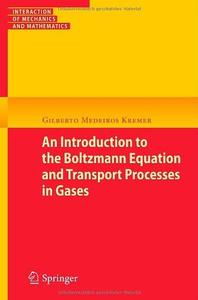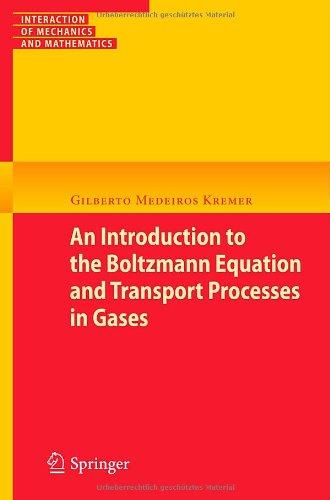Fundamentals of engineering thermodynamics: SI version By Michael J Moran; Howard N Shapiro
2006 | 847 Pages | ISBN: 0470030372 | PDF | 20 MB
2006 | 847 Pages | ISBN: 0470030372 | PDF | 20 MB
This book deals with the classical kinetic theory of gases. Its aim is to present the basic principles of this theory within an elementary framework and from a more rigorous approach based on the Boltzmann equation. The subjects are presented in a self-contained manner such that the readers can understand and learn some methods used in the kinetic theory of gases in order to investigate the Boltzmann equation. This book can be useful as a textbook for students and researchers who are interested in the foundations of the Boltzmann equation and in the classical methods used in the kinetic theory for the determination of the transport coefficients of the gases Chapter 1. Getting Started: Introductory Concepts and Definitions1. -- 1.1 Using Thermodynamics. -- 1.2 Defining Systems. -- 1.3 Describing Systems and Their Behavior. -- 1.4 Measuring Mass, Length, Time, and Force. -- 1.5 Two Measurable Properties: Specific Volume and Pressure. -- 1.6 Measuring Temperature. -- 1.7 Engineering Design and Analysis. -- Chapter Summary and Study Guide. -- Chapter 2. Energy and the First Law of Thermodynamics. -- 2.1 Reviewing Mechanical Concepts of Energy. -- 2.2 Broading Our Understanding of Work. -- 2.3 Broading Our Understanding of Energy. -- 2.4 Energy Transfer By Heat. -- 2.5 Energy Accounting: Energy Balance for Closed Systems. -- 2.6 Energy Analysis of Cycles. -- Chapter Summary and Study Guide. -- Chapter 3. Evaluating Properties. -- 3.1 Fixing the State. -- EVALUATING PROPERTIES: GENERAL CONSIDERATIONS. -- 3.2 p v T Relation. -- 3.3 Retrieving Thermodynamic Properties. -- 3.4 Generalized Compressibility Chart. -- EVALUATING PROPERTIES USING THE IDEAL GAS MODEL. -- 3.5 Ideal Gas Model. -- 3.6 Internal Energy, Enthalpy, and Specific Heats of Ideal Gases. -- 3.7 Evaluating Du and Dh using Ideal Gas Tables, Software, and Constant Specific Heats. -- 3.8 Polytropic Process of an Ideal Gas. -- Chapter Summary and Study Guide. -- Chapter 4. Control Volume Analysis Using Energy. -- 4.1 Conservation of Mass for a Control Volume. -- 4.2 Conservation of Energy for a Control Volume. -- 4.3 Analyzing Control Volumes at Steady State. -- 4.4 Transient Analysis. -- Chapter Summary and Study Guide. -- Chapter 5. The Second Law of Thermodynamics. -- 5.1 Introducing the Second Law. -- 5.2 Identifying Irreversibilities. -- 5.3 Applying the Second Law to Thermodynamic Cycles. -- 5.4 Defining the Kelvin Temperature Scale. -- 5.5 Maximum Performance Measures for Cycles Operating Between Two Reservoirs. -- 5.6 Carnot Cycle. -- Chapter Summary and Study Guide. -- Chapter 6. Using Entropy. -- 6.1 Introducing Entropy. -- 6.2 Defining Entropy Change. -- 6.3 Retrieving Entropy Data. -- 6.4 Entropy Change in Internally Reversible Processes. -- 6.5 Entropy Balance for Closed Systems. -- 6.6 Entropy Rate Balance for Control Volumes. -- 6.7 Isentropic Processes. -- 6.8 Isentropic Efficiencies of Turbines, Nozzles, Compressors, and Pumps. -- 6.9 Heat Transfer and Work in Internally Reversible, Steady State Flow Processes. -- Chapter Summary and Study Guide. -- Chapter 7. Exergy Analysis. -- 7.1 Introducing Exergy. -- 7.2 Defining Exergy. -- 7.3 Closed System Exergy Balance. -- 7.4 Flow Exergy. -- 7.5 Exergy Rate Balance for Control Volumes. -- 7.6 Exergetic (Second Law) Efficiency. -- 7.7 Thermoeconomics. -- Chapter Summary and Study Guide. -- Chapter 8. Vapor Power Systems. -- 8.1 Modeling Vapor Power Systems. -- 8.2 Analyzing Vapor Power Systems?Rankline Cycle. -- 8.3 Improving Performance?Superheat and Reheat. -- 8.4 Improving Performance?Regenerative Vapor Power Cycle. -- 8.5 Other Vapor Cycle Aspects. -- 8.6 Case Study: Exergy Accountin



